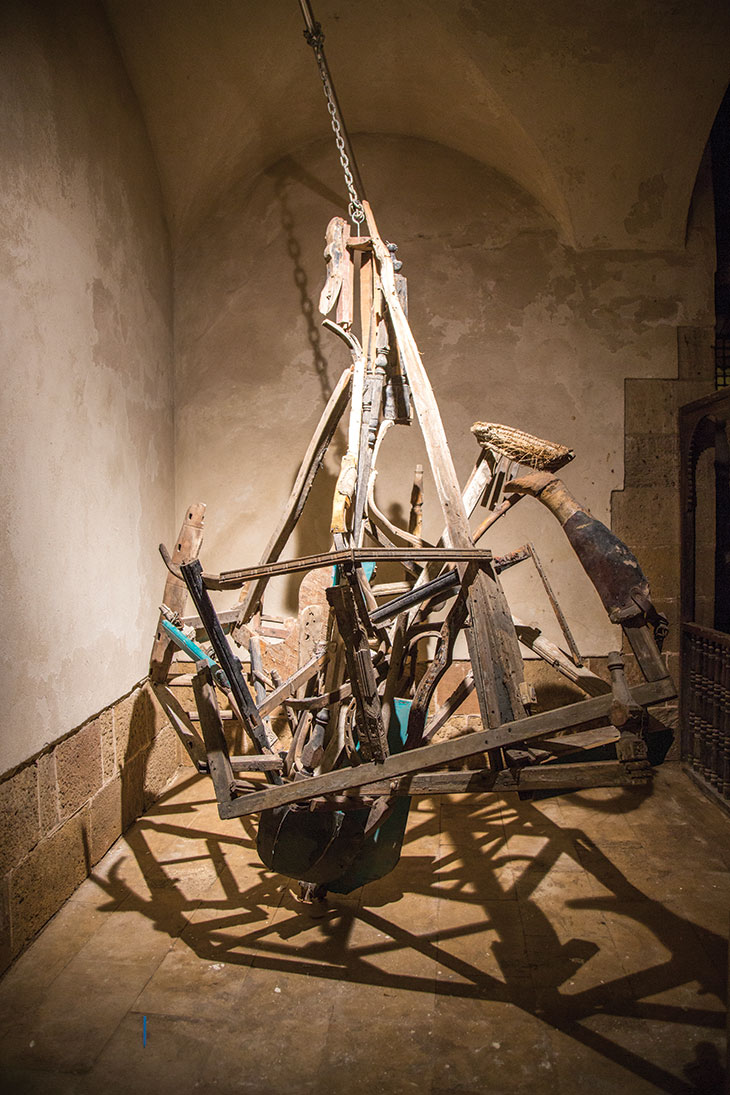Some ideas are just so good that it is difficult to imagine that no one thought of them before. Three years ago, Nadine Abdel Ghaffar’s art consultancy Art D’Égypte presented a modest exhibition based on a bold mission: to provide a much-needed platform for contemporary art in Egypt while also highlighting the country’s rich cultural heritage and the importance of conserving it. It was her way of linking the past to the creative present.
That first show – for just one night – had the work of leading national artists displayed alongside antiquities in the Egyptian Museum in Tahrir Square in Cairo, which when it opened in 1902 was one of the world’s first purpose-built museums. Long neglected, and looted and damaged during the revolution of 2011, the institution faces an uncertain future when the new Grand Egyptian Museum opens in Giza. The second iteration of Art D’Égypte, a month-long exhibition held last year at the Manial Palace, gave artists the opportunity to create site-specific installations and interventions in a wide variety of media for the building’s vast Ottoman, Moorish, European and Persian-style interiors. This time, there were also free public lectures given by international academics and curators, and a collateral educational programme. The exhibition drew 10,000 visitors, more than 2,000 of them tourists.
Installation view of Nobody Knows Anything about Them (2019), Ibrahim Ahmed in Bayt El Suhaymi for ‘Reimagined Narratives’, Cairo, 2019. Photo: courtesy Art d’Égypte

This year, once again under the auspices of the Egyptian Ministry of Antiquities and the patronage of UNESCO, the largest exhibition to date has opened in the ‘open-air museum’ that is El Mu’iz Street, one of the oldest streets in Egypt and the beating heart of Cairo for more than 1,000 years. Among the four historic venues are the medieval Qalawun Mosque complex and the 17th-century Bayt El Suhaymi. An educational programme has again been devised to teach local communities about the history of this remarkable street. The partnerships with both private and public organisations are in effect social enterprise, not only raising awareness of contemporary art and cultural heritage but also involving the renovation of infrastructure such as lighting and bathrooms. WiFi and security are provided for the duration of the show.
Abdel Ghaffar says: ‘Egypt’s art landscape has been forgotten and it is our responsibility as a nation with a great artistic heritage to reignite interest, and to develop cultural awareness and heritage conservation through sustainable initiatives.’ Placing the project in context, she adds: ‘Egypt needs an event like this because there are no art platforms. There are very few art institutions, and we lack commercial galleries. As a result, artists struggle to show their work in Egypt. Some of our most prominent artists actually live abroad and are showing their work in their homeland for the first time.’ And she believes this work should be shared nationally and internationally, because ‘people know Egypt’s past but they don’t know Egypt’s present’. This event, then, is ‘proof to the world that Egypt continues to support creativity with an open mind’.
Heba Y. Amin’s contribution to ‘Reimagining Narratives’ features this photograph of Muhammad Ali Pasha’s harem palace in Alexandria, taken by Horace Vernet on 7 November 1839. It is the first documented photographic image taken on the African continent

What Abdel Ghaffar describes as the ‘eternal bond between Egyptians and their roots, through all the different layers of our history’ is at the core of this year’s show, whose title is ‘Reimagined Narratives’. El Mu’iz Street is itself a palimpsest of the city’s Fatimid, Ayyubid, Ottoman and Mamluk past, with Greek, Roman, pharaonic and Coptic remains evident too. Illuminating these interwoven narratives are some 28 artists, many internationally recognised. Among them are the Berlin-based Heba Y. Amin and Ahmed El Shaer, who works between Cairo and New York. The Nubian-Egyptian Fathi Hassan, whose family was forced to leave their homeland with the building of the Aswan High Dam in 1952, highlights lost languages and oral traditions; Huda Lutfi blurs historical timelines and cultural boundaries; while Ibrahim Ahmed’s work challenges notions of national identity. Works of art are available for sale after the exhibition closes on 9 November.
‘Reimagined Narratives’ is at various venues on El Mu’iz Street, Cairo, until 9 November. For more information visit the Art D’Égypte website.



